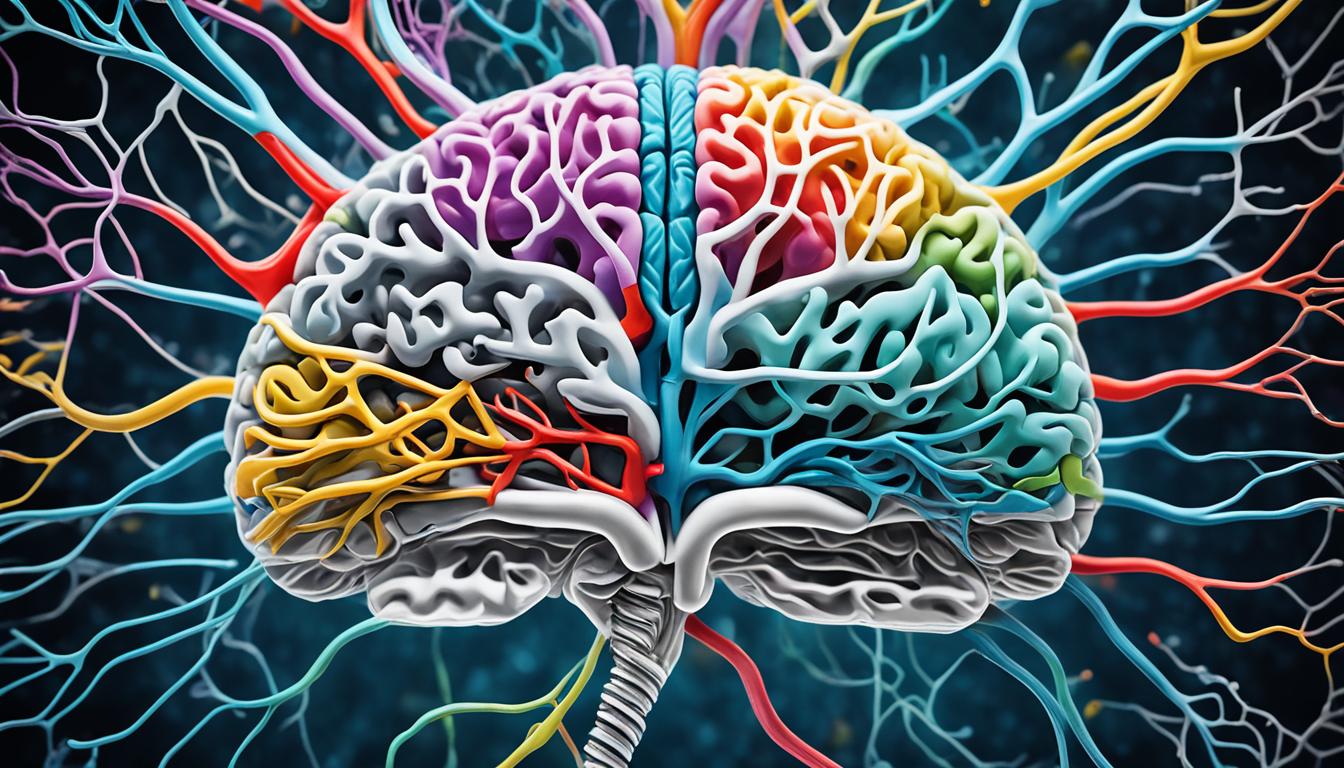What is Involved in a Master’s in Neuroscience?
The human brain has about 86 billion neurons. This shows the huge complexity of our nervous system. It also underlines why studying neuroscience is crucial. A Master’s in Neuroscience lets you dive deep into understanding the brain. You get to learn a lot about how our minds work.
Key Takeaways:
- A Master’s in Neuroscience program offers in-depth study of the nervous system and its functioning.
- Students gain knowledge in various areas of neuroscience, including computational neuroscience, cellular and molecular neuroscience, and psychological science.
- The curriculum focuses on experimental and theoretical methods for analyzing brain function and its application to mental health, cognition, development, and behavior.
- Career opportunities in neuroscience include research, academia, and industry, with a growing demand for professionals in the field.
- Skills gained in a Master’s in Neuroscience program include critical thinking, problem-solving, data analysis, and strong communication skills.
- Students have ample research opportunities to contribute to advancements in neuroscience and pursue independent projects.
- Admission requirements for neuroscience programs typically include a relevant bachelor’s degree, letters of recommendation, and a statement of purpose.
- Neuroscience coursework covers diverse topics such as neurophysiology, genetics, biochemistry, and electrophysiology.
- Many neuroscience programs require students to complete a thesis or research project demonstrating their knowledge and understanding of neuroscience.
Neuroscience Graduate Programs
Neuroscience graduate programs are for students who really want to understand the brain. They offer a mix of classes and research chances. You can aim for research, teaching, or industry jobs with this strong foundation.
Most programs ask for a bachelor’s degree in fields like biology or psychology. They might also want to see your research skills. You’ll need to send recommendation letters and explain why you want to study neuroscience.
In grad school, you’ll learn a lot about the brain. This includes how it works, its structure, and the role of genes. You’ll also look into how people think and learn.
| Course Title | Description |
|---|---|
| Neurophysiology | Explore the electrical and chemical processes that enable the functioning of the nervous system. |
| Neuroanatomy | Study the structure and organization of the brain and its intricate network of neural pathways. |
| Genetics | Examine the role of genes in brain development, neural function, and neurological disorders. |
| Cognitive Neuroscience | Investigate the neural basis of human cognition, including memory, perception, attention, and language. |
Some programs let you do your own research. This can be part of your thesis. Doing research helps you learn by doing. It also drives the field forward.
A neuroscience degree leads to many jobs. You can work in research, the industry, or with the government. Or, you might become a specialist in areas like how drugs affect the brain, brain imaging, or treating brain disorders. If you want, you can also keep studying and get a Ph.D.
If you dream of understanding the brain or helping those with brain issues, this program is for you. It will get you ready for a rewarding career full of discovery and helping others.
Curriculum for Master’s in Neuroscience
A Master’s in Neuroscience program aims to give students a deep understanding of the brain. Students take classes covering various topics essential for learning about the brain. These include Neurophysiology, Neuroanatomy, Cellular and Molecular Neuroscience, and Cognitive Neuroscience.
Students also get to choose electives based on their interests. They can study computational neuroscience or developmental neuroscience. These courses let students dive into advanced topics in neuroscience.
Programs also focus on seminars and journal clubs for discussions. These help students think critically and stay updated on new neuroscience research. The goal is to prepare students for careers in research, teaching, or industry.
Example of a Courses Schedule
Here’s a sample course schedule for a Master’s in Neuroscience:
| Year | Fall Semester | Spring Semester |
|---|---|---|
| 1 | Neurophysiology Neuroanatomy Cellular and Molecular Neuroscience |
Cognitive Neuroscience Elective Course: Computational Neuroscience Research Methods in Neuroscience |
| 2 | Advanced Topics in Neuroscience Elective Course: Developmental Neuroscience Thesis Research |
Seminar in Neuroscience Elective Course: Neuropharmacology Thesis Research |
This example gives an idea of a course schedule. The actual program might vary. The table shows how different neuroscience areas are studied across the program. The research, within the thesis, happens over both years. This allows students to do in-depth research with guidance.
Career Opportunities in Neuroscience
A Master’s in Neuroscience gives graduates many chances in both academics and industry. The field is growing fast. So, people with neuroscience skills are needed more. Here’s a look at some paths for Master’s in Neuroscience holders.
Research Scientist
Grads can be research scientists at universities, labs, or agencies. They do experiments, make studies, and help with groundbreaking work. They look into topics like neuropharmacology, cognitive neuroscience, or neuroimaging. Their work is key to finding new ways to treat brain conditions.
Pharmaceutical Researcher
With their degree, they can start in pharma, focusing on new drugs for brain issues. They join clinical trials, look at data, and work with different teams. Their efforts help bring new treatments to those who need them.
Neuropsychologist
Grads may become neuropsychologists. They focus on helping those with brain and behavior disorders. They might work in hospitals, rehabs, or on their own. Their job is to assess, treat, and better the lives of their patients.
Neurologist
Some grads opt for a medical degree to be neurologists. These experts diagnose and treat brain problems. This includes issues like epilepsy, multiple sclerosis, or Parkinson’s. They are important in taking care of patients’ nervous system health.
Academician
Some choose to teach, becoming professors. They lead classes, mentor students, and research. Academicians also share their findings in papers and at events. This lets them have a big impact on the world of science.
“A Master’s in Neuroscience opens doors to diverse and fulfilling career paths. Graduates can explore the complexities of the brain, contribute to cutting-edge research, and make a positive impact in the lives of individuals with neurological disorders.”
With tech and research moving fast, the need for neuroscience pros will only grow. From research to patient care, there are many ways a Master’s in Neuroscience can lead to a great career. If you’re into brain science, this path is full of opportunities to learn and make a difference.
Skills Gained in a Master’s in Neuroscience
A Master’s in Neuroscience equips students with valuable skills for many jobs. They learn about the nervous system and get the tools needed for success. Some key skills include critical thinking, problem-solving, data analysis, scientific writing, research methodologies, and an in-depth understanding of the nervous system.
Critical Thinking
Critical thinking is a vital skill. Students evaluate evidence and apply logic to solve problems. This approach helps in research and making sound conclusions.
Problem-Solving
Neuroscience students tackle tough questions using creative solutions. They learn to overcome challenges in their research and professional life.
Data Analysis
Data analysis is key in neuroscience. Students become skilled at interpreting data and spotting patterns. These skills are vital for presenting research in a clear way.
Scientific Writing
Scientific writing is crucial. Students write with clarity and structure, sharing their findings with others in the scientific community.
Research Methodologies
Students learn various research methodologies. This prepares them to carry out experiments, collect and analyze data accurately. They can then contribute to diverse neuroscience projects and fields.
Understanding of the Nervous System
A key goal is understanding the nervous system. Students learn about the brain’s structure, function, and organization. This knowledge is applied in clinical neuroscience and other specialized areas.
Effective Communication
Strong communication is essential. Students learn to share their research and scientific ideas clearly. This skill is key for scientific progress and teamwork.
With these skills, graduates are ready for roles in research, teaching, or the industry. Their expertise can lead to new discoveries, improved brain understanding, and impactful neuroscience work.
Research Opportunities in Neuroscience
A Master’s in Neuroscience program opens up many paths for research, pushing the boundaries of our understanding. Students dive into hands-on work, learning and contributing to what we know about the brain and the nervous system.
Working in Research Laboratories
In these labs, students are at the forefront of experimentation, data analysis, and teamwork. They leverage their learning, gaining critical research skills that are key in neuroscience.
Collaborating on Ongoing Projects
Working with seasoned researchers, students can join in on advanced studies. It lets them explore in-depth, offering new insights and a wider view of the field.
Independent Research Projects
Grad programs often let students lead their own studies. This is where they can ask their big questions, set up experiments, and think critically as they work through their projects from start to finish.
Research in neuroscience covers a lot. For instance, some delve into brain disorders, while others look at how brain cells communicate. You might also find students digging into the brain’s reaction to drugs or the reasons behind certain behaviors.
Getting involved in research during a Master’s leads not only to new knowledge. It hones students’ skills for future scientific work, potentially making huge changes in neuroscience and the world it impacts.
Admission Requirements for Neuroscience Programs
Neuroscience programs have different rules for getting in. Most need a bachelor’s degree in biology, psychology, or neuroscience. They might want a specific GPA or letters of recommendation too.
Some schools could ask for the GRE test. Check each program’s details carefully to not miss any steps.
Minimum Requirements:
- Bachelor’s degree in a related field (biology, psychology, or neuroscience)
- Minimum GPA (specific requirement may vary)
- Letters of recommendation
You might also need to write a statement of purpose and give your resume. These show why you’re interested and what experience you have.
Review every program’s rules and deadlines to make sure your application is complete.
Fully knowing and meeting the requirements boosts your chance of being accepted. It lets you follow your dream of studying the brain better.
Comparison of Admission Requirements for Neuroscience Programs
| University/Institution | Bachelor’s Degree Requirement | GPA Requirement | Letters of Recommendation | Standardized Tests | Additional Documents |
|---|---|---|---|---|---|
| University A | Related field (biology, psychology, or neuroscience) | 3.0 or higher | 2 | GRE | Statement of purpose, resume/CV |
| University B | Life sciences | 3.5 or higher | 3 | GRE | Statement of purpose, research experience |
| University C | Any field | 2.5 or higher | 2 | None | Statement of purpose, transcript |
Neuroscience Coursework and Thesis Requirements
In a Master’s program in Neuroscience, students study a wide range of topics. These include neurophysiology, neuroanatomy, and molecular neuroscience. They also learn about cognitive neuroscience and genetics (Neuroscience coursework). This knowledge helps them understand the core ideas in neuroscience.
In addition to classes, students must complete a thesis or research project (Neuroscience thesis requirements). This part of the program allows students to do their own research. They work closely with advisors to make new findings in neuroscience.
Writing a thesis lets students focus on their interests in the field. It involves deep research and using skills learned in class. This work helps students improve their research and analytical abilities.
Working on a thesis lets students grow in many ways. For example, they improve their critical thinking and writing skills. These are important for success after they graduate.
Finishing a thesis shows others that a student is dedicated and knowledgeable. It also helps with finding good jobs. Employers appreciate people who can do research and add to neuroscience (Neuroscience coursework, Neuroscience thesis requirements).
| Benefits of Neuroscience Coursework and Thesis | Neuroscience Coursework | Neuroscience Thesis |
|---|---|---|
| Develop a comprehensive understanding of neuroscience theories and concepts | ✓ | |
| Gain valuable research experience | ✓ | |
| Contribute to the existing body of knowledge in neuroscience | ✓ | |
| Enhance critical thinking, problem-solving, and data analysis skills | ✓ | |
| Refine scientific writing and research methodologies | ✓ |
Conclusion
A Master’s in Neuroscience lets students dive deep into this exciting field. It gives them advanced skills and knowledge. They learn a lot about the brain, its parts, and how it works. Plus, they get to use the latest tools for research.
After getting their Master’s, students can choose from many careers. They might work in labs, for drug companies, or in schools or government. The job market in this area is growing fast as we learn more about the brain.
This program helps learners understand the nervous system better. They also pick up skills like critical thinking and data analysis. This knowledge lets them help solve brain-related health problems.
So, if you’re fascinated by the brain and want to help people, this field has a lot to offer.







